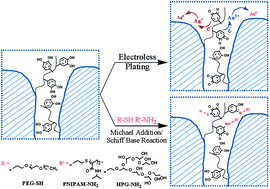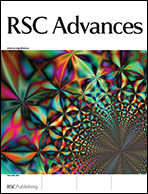A poly(vinylidene fluoride)-graft-poly(dopamine acrylamide) copolymer for surface functionalizable membranes†
Abstract
Poly(dopamine acrylamide)-grafted poly(vinylidene fluoride) (PVDF-g-PDA) microfiltration (MF) membranes were fabricated via (i) thermally-induced radical graft copolymerization of pentafluorophenyl acrylate from ozone-pretreated PVDF, (ii) reactive ester–amine reaction with dopamine hydrochloride, and (iii) membrane casting via phase inversion. The resulting catechol-containing PVDF-g-PDA MF membranes can be further functionalized via spontaneous reduction and chelating of Ag and Au nanoparticles on the surface, and via grafting of thiol-terminated poly(ethylene glycol) (PEG-SH), amino-terminated poly(N-isopropylacrylamide) (PNIPAM-NH2) or amino-terminated hyperbranched polyglycerol (HPG-NH2) in Michael addition or Schiff base reactions. The as-synthesized PVDF-g-PDA/Ag nanoparticles composite MF membrane was explored for its antibacterial efficacy against Gram-negative Escherichia coli (E. coli) and Gram-positive Staphylococcus aureus (S. aureus). The resulting PVDF-g-PDA/Au nanoparticles composite MF membrane was investigated as the catalytic support for the reduction of 4-hydroxynitrobenzene. The obtained PVDF-g-PDA/PNIPAM, PVDF-g-PDA/PEG and PVDF-g-PDA/HPG MF membranes exhibit thermo-responsive, biocompatible and anti-fouling properties, respectively.


 Please wait while we load your content...
Please wait while we load your content...